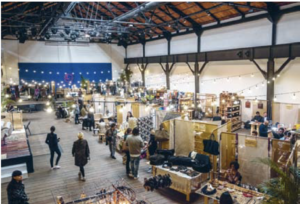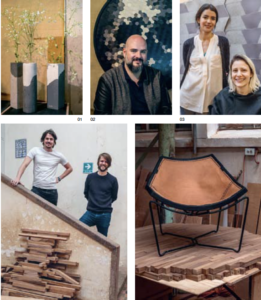Monocle, May 2016
The creative revolution that’s taking place in Mexico’s capital is a citywide affair. From furniture makers to homeware brands, Monocle takes a seat at the drawing board with a fresh and ambitious cadre of talent.
Crisscross Mexico City – your pace dependant on how bad its notorious traffic is that day – and you’ll find no shortage of design icons. There’s the renowned casa of architect Luis Barragán, whose fluorescent tones only reveal themselves once you step through the front door; then there’s the brutalist brick, stone and concrete hulk of Pedro Ramírez Vázquez’s National Museum of Anthropology. The city has a diverse modernist tradition and if you delve deeper you’ll find light-filled offices that defy their nondescript façades and plant-filled, colonial-style patios. Yet despite this promising panorama, contemporary Mexico City has sometimes struggled to harness a reputation as a design centre or creator of high-quality products. Change, however, is under way.
“We’ve been working for decades,” says designer Emiliano Godoy. “But it’s only in the past five years that the industry has started to hire us.” Godoy is speaking from Estación Indianilla, a vast downtown cultural centre and former tram-repair warehouse; it is hosting the inaugural Caravana Americana, a trade fair showcasing design from around Mexico. Godoy, who works as an industrial designer for the Monterrey-based Grupo Lamosa and crafts everything from furniture to carpets, has just given a speech. It’s easy to see why he’s been invited when you consider his international success.
With the relish of a university professor, Godoy explains to us how up to now Mexico City has been better known as a hub for cheap labour and mass production. But all the creative ingredients exist: “The industry is there but there isn’t a point of connection – but I’m optimistic for these people,” he says pointing to the stands dotted around the room. Indeed, not long ago a trade fair such as Caravana – or others such as La Lonja MX or Design Week México – wouldn’t have existed due to the lack of a market. Yet the quality and diversity of the design here is undeniable.
Over in one corner, designer Ricardo Casas is showing off his cocktail cart by offering spectators a shot of mezcal. “We have such giant potential,” he says between sips of the potent tipple. Casas has been running a studio for the past eight years and launched his own brand of homeware called Shelf – including beautiful vases that are half-smashed and remoulded in a different colour – in February. Casas produces contemporary pieces from ceramic and concrete, keen to avoid any Mexican artisanal clichés.
Across the room, angular lights fashioned from glass are being sold by Candela; nearby Déjate Querer, a company formed by Rocío Cortés and Ana Paula Alatriste, has intricately made wall pieces and carpets created from hand-assembled pieces of interlocking wool.
And then there’s Utilitario Mexicano, a shop that has a stand at the fair and whose mission is to save classic Mexican industrial design. “My friends say that we collect objects in danger of extinction,” says co-owner Enrique Arellano with a smile, pointing to a locally made jug he says could pass as Bauhaus.
Much of the design at Caravana is handmade and produced on a small scale. But in a city where designers often have to be their own researchers, marketers and financiers, it makes sense. This may go some way to explaining why some of Mexico City’s most exciting design is focused on wood, a material that is easy to source and doesn’t need large amounts of industrial treatment.
Away from the buzz of the fair in the San Rafael neighbourhood, an unmarked street-corner building announces the workshop of Paul Roco. Inside, the air thick with wood dust, owners Rodrigo Berrondo and Pablo Igartúa – a mechanical engineer and architect respectively – watch over the furniture production as Berrondo’s dog, an Australian shepherd called Bocha, wanders around. Inspired by Luis Barragán, among others, the pair produce modernist furniture that mixes delicate aesthetics with functionality, purposely leaving stitching and the untreated side of the leather to show how materials have been worked on.
Across town is Swedish-Mexican designer Alexander Díaz Andersson, who works with New York furniture firm Luteca. He is producing his own Scandinavian-influenced mid-century pieces and has licensed the designs of renowned architect Pedro Ramírez Vázquez. Then there are other studios such as La Carpintería MX (LCMX) and La Metropolitana, the latter working on exporting software that factories around the world can license.
“There’s much more design confidence now,” says Paul Roco’s Igartúa, looking up from sketching a design at his office desk. “People are taking risks.” Little by little, a creative industry is emerging.
Getting graphic
Mexico City’s branding and graphic-design studios are brimming with talent; here are three of the best.
Savvy Studio
The Mexico City studio, which also has an outpost in Monterrey, recently opened an office in New York. Branding and interiors include NY’s forthcoming Gowanus Yard hotel.
savvy-studio.net
Futura
Spanning branding, interiors and web design, Futura works in countries as diverse as Japan, Côte d’Ivoire and India. “We’ve always been a small team,” says cofounder Vicky González. “At some point we’ll have to expand.”
byfutura.com
La Metropolitana
Another do-it-all studio that produces furniture, designs interiors and covers branding and editorial design (including last year’s Design Week México brochures).
lametropolitana.com.mx
Furniture designers to watch
Paul Roco
Pablo Igartúa (Paul) and Rodrigo Berrondo (Roco) first started working with hotels and residential buildings, including decking out Grupo Habita’s Downtown Mexico hotel with their Dante seat. Now the focus is on producing an in-house line of furniture in their typical rugged, all-natural-dye style.
paulroco.com
Alexander Díaz Andersson
Raised in Sweden, Díaz Andersson has been back in Mexico a decade, first in Mérida and now the capital. Working out of the Atra furniture workshop alongside his mother, he makes Scandinavian mid-century inspired pieces in wood and also reproduces the designs of Ramírez Vázquez. “You can still find a beautiful balance of people working with machinery and by hand in Mexico City,” he says.
luteca.com
LCMX
Formed in 2009 by two brothers inspired by their father, who was a carpenter. The focus is on tables and chairs but perhaps their most interesting products are the Felina lights. Co-owner Ricardo Rodríguez Elías says the growing scene is good for business because it “helps improve the quality of products”.
lc-mx.com

